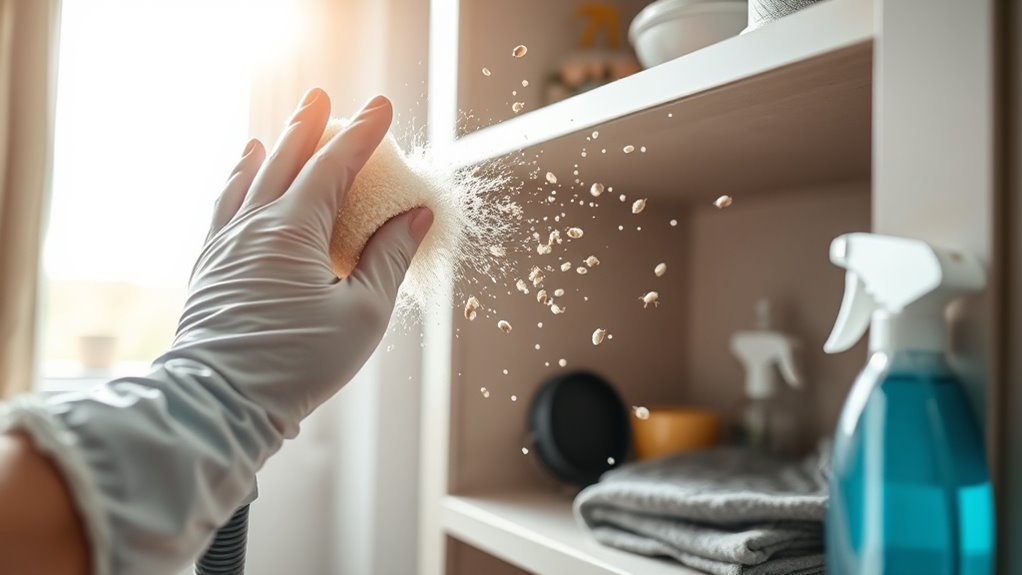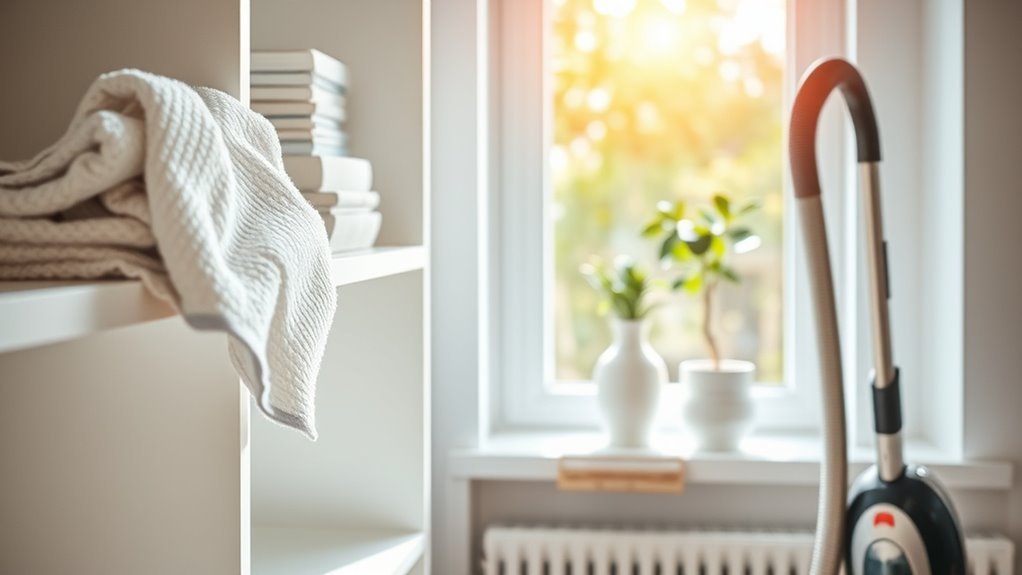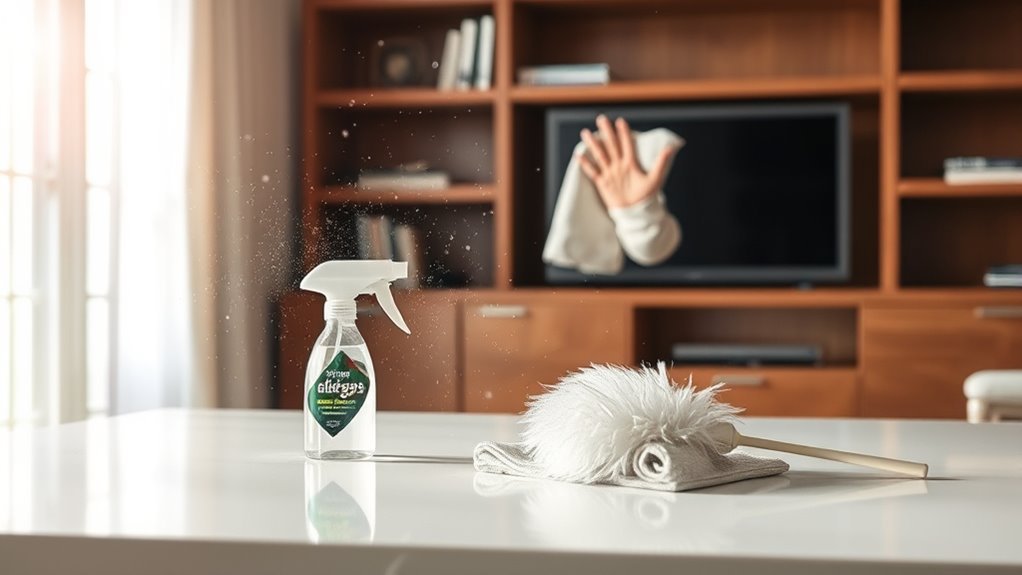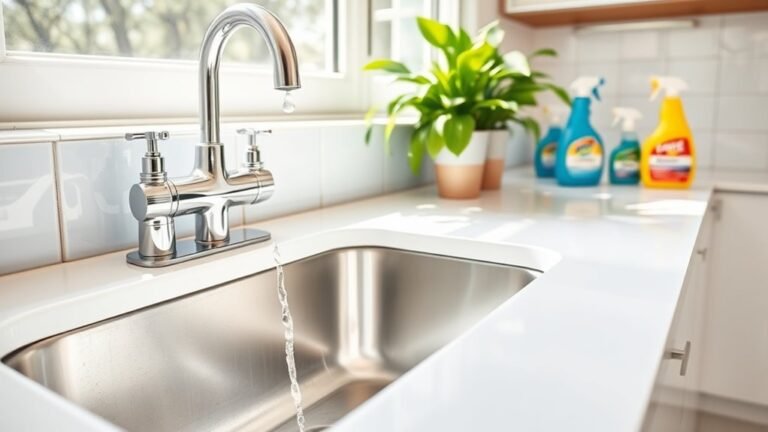Step-By-Step Guide to Cleaning Allergens
To clean allergens like dust mites, pet dander, and mold, start by identifying common hiding spots such as bedding, carpets, and air vents. Gather supplies like microfiber cloths and a HEPA-filter vacuum. Dust top to bottom, vacuum slowly with the right settings, and wash fabrics weekly using hypoallergenic detergent. Control humidity at 30-50% with dehumidifiers and clean air vents regularly. Establish a consistent cleaning schedule to keep allergens low and your home fresh. Keep going if you want to discover more helpful tips.
Identifying Common Household Allergens

Where are allergens hiding in your home? You might be surprised to find that common allergens lurk in everyday places—dust mites in bedding, pet dander on furniture, mold in damp corners, and pollen tracked inside on shoes. Identifying sources is your first step toward reclaiming your space. You don’t have to live confined by sneezes or itchy eyes. Focus on areas like carpets, curtains, and air vents where allergens accumulate unnoticed. Recognizing these hidden irritants empowers you to target them effectively, giving you freedom from allergy triggers. By pinpointing common allergens around you, you control your environment instead of letting allergens control you. Knowing where to look means you can breathe easier and enjoy your home without limits.
Preparing Your Cleaning Supplies
Now that you know where allergens tend to hide, gathering the right cleaning supplies will make tackling them much easier. Start by selecting effective cleaning tools like microfiber cloths and HEPA-filter vacuums—they trap dust and allergens without spreading them around. Next, pick allergen sprays designed to neutralize pollen, pet dander, and dust mites. These sprays can reduce allergens on fabrics and surfaces, giving you more freedom from sneezing fits. Keep your supplies organized so you can grab what you need quickly and stay motivated. By preparing smartly, you’re not just cleaning—you’re reclaiming your space and breathing easier. With the right tools and sprays ready, you’ll feel empowered to take control of your environment, making allergen-free living a straightforward, liberating routine.
Decluttering to Minimize Dust Accumulation

To keep dust—and allergens—at bay, you’ll want to start by decluttering your space. Clearing out unnecessary items makes cleaning easier and reduces places where dust can settle. Let’s explore simple techniques to help you maintain a clutter-free home that supports better air quality.
Benefits of Decluttering
Clutter often invites dust, making it harder to keep your living space clean and allergen-free. When you declutter, you not only reduce dust buildup but also create an environment that fosters mental clarity. With fewer distractions around you, your mind feels lighter and more focused. This clear space paves the way for increased productivity, as you can concentrate better on tasks without the constant visual noise of clutter. Plus, a tidy environment supports a sense of freedom, allowing you to move and breathe easily without the stress of mess. By embracing decluttering, you’re taking a powerful step toward maintaining a healthier, allergen-reduced home while boosting your overall well-being and efficiency. It’s a simple change that brings big benefits.
Effective Decluttering Techniques
Reducing dust buildup starts with knowing how to declutter effectively. To embrace a decluttering mindset, focus on keeping only what truly adds value to your life. This minimalist approach not only frees your space but also cuts down dust-collecting surfaces. Start by tackling one area at a time, sorting items into keep, donate, or discard piles. Resist the urge to hold onto things “just in case.” The less you own, the easier it is to clean and the less dust you’ll face. Remember, decluttering isn’t about perfection—it’s about creating breathing room and freedom from excess. By adopting these effective decluttering techniques, you’ll minimize allergens and enjoy a lighter, clearer environment that supports your well-being.
Maintaining a Clutter-Free Space
Even after decluttering, keeping your space clear requires consistent effort. To truly maintain a clutter-free environment, focus on organizing spaces thoughtfully. When everything has a designated place, it’s easier to put items away quickly, preventing dust from settling on unnecessary surfaces. This approach not only helps minimize allergens but also promotes a sense of freedom by reducing visual chaos. By minimizing distractions caused by clutter, you’ll find it simpler to keep your environment clean and inviting. Make it a habit to regularly assess what you own, removing anything that no longer serves you. This ongoing commitment to organizing spaces guarantees your home stays fresh, allergen-free, and a sanctuary where you can breathe and relax without worry.
Effective Dusting Techniques

To tackle allergens effectively, you’ll want to master a few dusting techniques that capture dust rather than just moving it around. Choosing the right duster types is key; microfiber cloths or electrostatic dusters trap particles, preventing them from resettling. Pay attention to dusting frequency — aim for at least once a week in high-traffic areas to keep allergens low. When you dust, work from top to bottom to avoid spreading dust onto cleaned surfaces below.
Master dusting with microfiber or electrostatic cloths weekly, working top to bottom to reduce allergens effectively.
- Use dampened microfiber cloths for delicate surfaces to avoid scratches.
- Focus on hidden spots like ceiling fans and vents where dust accumulates.
- Consider using a vacuum with a brush attachment for upholstered furniture.
These strategies let you reclaim your space free from irritating allergens efficiently.
Vacuuming Strategies for Allergen Removal
To reduce allergens effectively, you’ll want to choose a vacuum with a HEPA filter that traps tiny particles. When vacuuming carpets, use slow, deliberate strokes to lift dust and allergens from deep within the fibers. These simple steps can make a big difference in improving your indoor air quality.
Choosing Effective Vacuum Filters
Choosing the right vacuum filter can make a huge difference in reducing allergens in your home. You want a filter that maximizes allergen reduction while fitting your lifestyle and vacuum type. HEPA filters stand out because they trap 99.97% of particles, including pollen and pet dander, making allergen traps more effective. Regular filter maintenance and timely filter replacement are essential to keep efficiency high. Different vacuum brands offer varying filter technologies, so pick one designed for your cleaning needs and ease of upkeep.
- Prioritize HEPA filters for superior allergen control
- Match filter types to your vacuum’s design for best performance
- Schedule regular filter maintenance and replacement to maintain efficiency
This empowers you to breathe easier and enjoy a cleaner, freer home.
Vacuuming Techniques for Carpets
Although vacuuming might seem straightforward, using the right techniques on carpets can considerably boost allergen removal. First, know your carpet types—thicker, plush carpets trap more allergens, so you’ll want a vacuum with strong suction and adjustable height settings to reach deep layers without damaging fibers. For low-pile carpets, a vacuum with a beater bar or brush roll works best to loosen debris. Make sure your vacuum features a HEPA filter to capture tiny particles, preventing them from escaping back into the air. Vacuum slowly in overlapping strokes, covering every inch to lift embedded allergens. Don’t forget high-traffic areas where allergens accumulate faster. Regular and mindful vacuuming tailored to your carpet type frees your space from hidden irritants, letting you breathe easier and enjoy true freedom at home.
Washing Bedding and Fabrics Properly
When you wash your bedding and fabrics correctly, you can greatly reduce allergens like dust mites and pet dander that often accumulate there. Different bedding types require specific fabric care, so check labels before washing. Use hot water when possible to kill allergens effectively, but avoid damage by following care instructions.
Proper washing of bedding with hot water and care label guidance reduces allergens like dust mites and pet dander.
To keep your fabrics allergen-free and long-lasting, remember:
- Wash bedding weekly to prevent buildup of allergens.
- Use hypoallergenic detergents to avoid skin irritation.
- Dry fabrics thoroughly, preferably in sunlight or on a high heat setting, to eliminate moisture that supports allergens.
Controlling Indoor Humidity to Prevent Mold
Since mold thrives in damp environments, controlling indoor humidity is key to preventing its growth. You want your home to feel fresh and free, not weighed down by musty odors or hidden mold. Aim to keep indoor humidity levels between 30-50%. Using a reliable dehumidifier or ensuring proper ventilation in kitchens and bathrooms helps maintain this balance. Regularly check for leaks and fix them promptly to avoid excess moisture buildup. By mastering humidity control, you reduce mold spores that trigger allergies and respiratory issues. Taking these steps gives you control over your space, promoting a healthier environment where you can breathe easy and live freely. Mold prevention starts with simple, consistent actions that safeguard your home’s air quality and your peace of mind.
Cleaning Air Vents and Filters
Because air vents and filters play a crucial role in circulating clean air throughout your home, keeping them clean is important to reducing allergens. Neglecting vent cleaning can allow dust, pollen, and pet dander to accumulate, compromising your indoor air quality. Regular filter replacement guarantees your HVAC system works efficiently, trapping harmful particles before they reach your lungs. To maintain freedom from allergens:
- Vacuum vents and registers to remove dust buildup.
- Replace HVAC filters every 1–3 months, depending on usage.
- Consider high-efficiency particulate air (HEPA) filters for enhanced allergen control.
Maintaining a Regular Cleaning Schedule
Although keeping your home allergen-free can seem overwhelming, sticking to a regular cleaning schedule makes it manageable and effective. You’ll find that setting a consistent cleaning frequency—whether it’s daily, weekly, or monthly—helps keep allergens at bay without feeling like a burden. Use schedule reminders on your phone or calendar to stay on track effortlessly. This way, you won’t have to constantly think about when to clean; your reminders will prompt you, freeing up mental space. Consistency is key, so pick a rhythm that fits your lifestyle and stick with it. By maintaining this routine, you’re not just cleaning—you’re creating a healthier, freer living space where allergens don’t control your comfort.
Frequently Asked Questions
Can Cleaning Allergens Reduce Allergy Medication Needs?
Yes, by focusing on allergy prevention through regular cleaning, you can often reduce your reliance on medication. Keeping your environment free of allergens offers effective medication alternatives that let you enjoy greater freedom without constant pill-popping. When you tackle allergens head-on, your symptoms can lessen, allowing you to breathe easier and live more comfortably. So, investing time in thorough cleaning can really help you manage allergies naturally and feel more in control of your health.
Are Natural Cleaning Products Effective Against Allergens?
Want freedom from harsh chemicals and effective cleaning? Natural alternatives can be surprisingly powerful, but their cleaning efficacy varies. You’ll find some natural products cut allergens like dust and pet dander just as well as traditional cleaners, while others might need more elbow grease or frequent use. If you’re seeking a gentle yet effective way to reduce allergens, exploring natural options gives you control and peace of mind without compromising your health or freedom.
How Often Should Pets Be Groomed to Reduce Allergens?
You should maintain a consistent grooming frequency to keep pet dander under control and reduce allergens in your home. Ideally, grooming your pet once or twice a week helps minimize loose fur and dander that triggers allergies. Regular brushing and occasional baths let you enjoy your pet freely without the constant worry of allergens lingering around. This simple routine keeps the air cleaner and your living space more comfortable for everyone.
Do Air Purifiers Eliminate All Types of Allergens?
You shouldn’t expect air purifiers to eliminate all types of allergens completely. Different air purifier types target various particles—HEPA filters excel at trapping pollen, pet dander, and dust mites, while activated carbon filters handle odors and some chemicals. For thorough allergen removal, you’ll want a purifier suited to your specific needs. Remember, combining air purifiers with good ventilation and regular cleaning frees you from persistent allergens more effectively.
Can Certain Plants Help Reduce Indoor Allergens?
Oh sure, just invite a few allergy friendly plants indoors, and presto—your indoor air quality will be magically perfect! While they won’t banish allergens like superheroes, certain plants like spider plants and peace lilies can help reduce dust and toxins a bit. But don’t rely solely on them; combine with proper cleaning and ventilation to truly breathe free from sneezes and sniffles. Plants are allies, not miracle workers.






